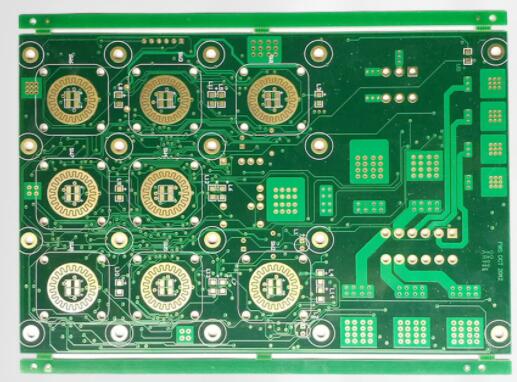Selection, production and processing of high-frequency board
One, the definition of PCB high-frequency board
High frequency board refers to a special printed circuit board with high electromagnetic induction frequency used in high frequency (frequency greater than 300MHz or light wavelength less than 1m) and microwave heating (frequency greater than 3GHz or light wavelength less than 0.1m) industries. It is a general rigid printed board manufacturing method based on polyimide film. It is part of a microwave heating process, or a printed circuit board produced with a unique solution. Generally speaking, the high-frequency board can be regarded as a PCB circuit board with a frequency greater than 1GHz.
With the rapid development of science and technology, more and more mechanical equipment is designed to be used in the microwave heating frequency band (>2gbhz) and even the centimeter wave industry (30ghz), which also represents the higher frequency and higher requirements for PCB substrates. For example, the raw material of the substrate must have high-quality electrical properties and excellent organic chemical reliability. With the increase of the data frequency of the switching power supply, the damage law of the base material is very small, so the necessity of the high-frequency board is emphasized.

Second, the main purpose of the high-frequency board
1. Mobile communication products, intelligent lighting system software
2. Power amplifier, low noise amplifier, etc.
3. Power divider, coupler, duplexer, filter and other microwave sensor devices
4. The high frequency of electronic products is the development trend of automobile collision avoidance system software, communication satellite system software, wireless communication system software and other fields.
Three, high-frequency board classification
3.1 Adding thermosetting plastic raw materials to powder porcelain
A. Manufacturer:
1. Rogers' 4350B/4003C, RO3000, RT, TMM series products
2. 25N/25FR, AD/AR, IsoClad, CuClad series products of Arlon Enterprise
3. Taconic enterprise TLG, RF, TLX, TLY series products
4. TP-2, F4B, F4BM, F4BK heated by Taixing microwave
B. Production and processing methods:
The production and processing steps of high-frequency board and epoxy resin/laminated glass cylinder (FR4) are similar, only the board is relatively brittle and it is easy to break the board. When drilling holes and gongs, the service life of nozzles and gong knives should be reduced by 20%.
1. Cutting material: Be sure to save the protective film cutting material to avoid scratches and embossing
2. Punch:
1. Using the newly upgraded 130 size drill bit, the working pressure of the presser foot is 40psi
2. The aluminum block is the back cover, and then use the millimeter melamine cutlery block to hold the PTFE plate tightly
3. After drilling, use a hot air gun to blow out the smoke and dust in the hole
4. Use the most stable drilling rig, the main drilling parameters (mostly the smaller the hole, the faster the drilling speed, the smaller the chip load and the smaller the return speed)
3. Hole solution
Plasma treatment or sodium naphthalene active solution is conducive to pore metallization
4. PTH sinking copper
1. After micro-etching (the micro-etching rate is controlled by 20 micro feet), start pulling the board from the hydraulic cylinder in the PTH
2. If necessary, pass the second PTH, just start the board from the beginning of the estimated 㓎cylinder
4. Solder mask
5. The previous solution: choose acid-alkaline plate washing instead of mechanical equipment to grind the plate
1. Before dissolving, after baking plate (90 degree Celsius, 30min), brush with green oil and dry
2. The baking sheet is divided into three sections: a section of 80°C, 100°C, and 150°C for 30 minutes (if oil is found to splash on the surface of the substrate, it can be repaired: wash off the green oil and re-solve the activity problem)
6, gong board
Lay the tissue paper on the PTFE board, and clamp it on the left and right sides with the FR-4 substrate board or phenolic resin base plate that has a thickness of 1.0MM etching process to remove copper:
The burrs on the edge of the gong board must be carefully repaired by hand to prevent damage to the base material and copper surface, and then separated with a special specification sulfur-free paper, and watched for inspection. To reduce the burrs, the most important thing is the whole gong board. The actual effect of the process should be excellent.
Fourth, the production process
1. NPTH's PTFE board production and processing steps: cutting-punching-wet film-inspection-etching process-corrosion inspection-solder mask-identifier-spray tin-forming-inspection-full inspection-packaging-delivery
2. PTH's PTFE board production and processing steps: cutting-punching-hole solution (plasma treatment or sodium naphthalene active solution)-copper immersion-board electricity-wet film-inspection-picture electricity-etching process-corrosion inspection-resistance Welding-Identifier-Tinning-Forming-Inspection-Full Inspection-Packaging-Delivery
V. Summary
High-frequency board production and processing problems
1. Immersion copper: not easy to be copper on the edge of the hole
2. Map transfer, etching process, route vacancy of graphic boundaries, manipulation of sand holes
3. Green oil process: operation of green oil adhesion and green oil foaming
4. Strictly control surface scratches in each process